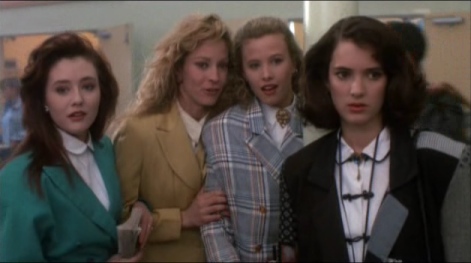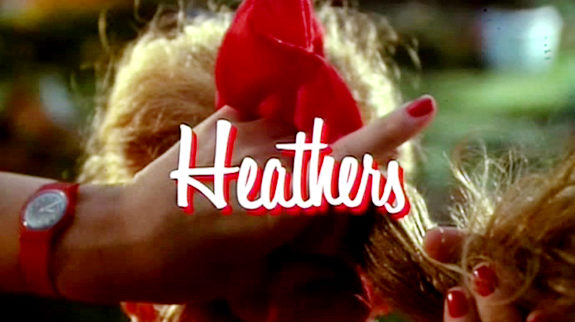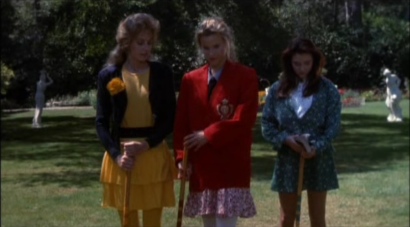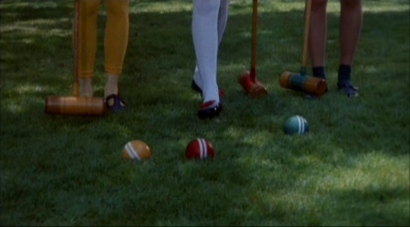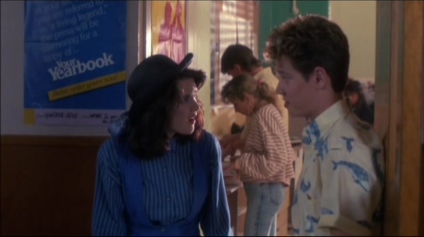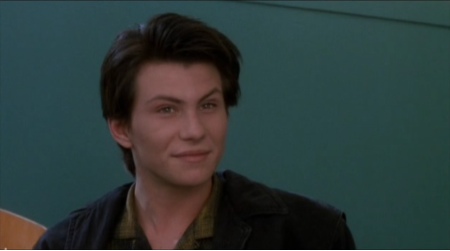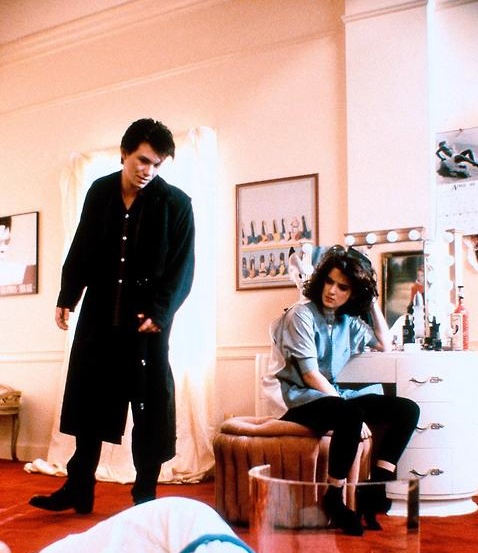|
Heathers(Lehmann, 1988)
Heathers Note: The following analysis assumes that the reader has already seen the movie. It discusses plot points and may “spoil” the experience for some readers. I therefore advise you to watch the movie before reading this; you can always bookmark this page, watch the movie, and come back. If, however, you want to decide whether this movie is or is not worth watching, everything above the black line is spoiler-free. Ah, youth. A time for wonder, exploration, and innocence, when the future was wide open and full of promise. Such, such were the joys! Yeah, right. For anyone with half a brain, and many without one, high school is a series of mortifying episodes, punctuated by the unspeakable cruelty of adolescents with power. Put a large group of disparate people together, and the delicate social ecosystem will always sit at the verge of self-destruction. In other words, high school is society writ small. How very. Such is a thumbnail sketch of Heathers, a dark comedy about suburban American high school. The Heathers are “the most popular clique in school,” three girls with the same first name. Heather Chandler, the head of the clique, amuses herself by humiliating her less fortunate peers. Veronica Sawyer (Winona Ryder) is her protegé, an intelligent and attractive student who gained a toehold into their exclusive world...and hates every minute of it. Much is interesting in this movie, most of it outside the scope of this article. I will try to show how fashion underlines and draws out the message of the movie, without veering into the abstract or the incomprehensible. Wish me luck! Heather Chandler: Well, fuck me gently with a chainsaw. Do I look like Mother Teresa? Veronica Sawyer: Heather, why can't you just be a friend? Why do you have to be such a mega-bitch? J.D.: The only place different social types can genuinely get along with each other is in heaven. At its heart, this movie is about three clashing outlooks, worldviews, philosophies––call them what you will. The Heathers outlook is a form of social Darwinism, that "real life sucks losers dry. If you want to fuck with the eagles, you have to learn to fly." This is the dark side of the American dream: If you can be anything you want, then scum choose their fate. The second philosophy, believed by Veronica, is that people should be treated with respect, dignity and kindness, especially the unfortunate and awkward. The third philosophy, espoused by J.D., is that ends justify means, and those who hurt others, who contribute nothing, deserve to die. Unlike Heathers-style social darwinism, J.D. views violence as an integral part of maintaining order. As he tells Veronica late in the movie, they've "scared people into not being assholes." One of the more interesting statements the movie makes––perhaps without the creators being aware of it––is how a too-tolerant attitude can lead to collusion with power. For all her human decency, Veronica sells out her best friend for a bunch of cruel “Diet Cokeheads,” and can never quite answer J.D.’s constant question of what you should do with sadists, if you can't kill them. Though the movie sympathizes with Veronica’s outlook more than the other two, its optimistic coda belies a pessimistic undertone. How, exactly, do you override human nature? How do you make people get along? Not by kumbaya bullshit; not by chaos; not even by "scaring people into not being assholes." It's no wonder this remains unresolved: philosophers, social scientists, politicians, activists, PhDs, and saints have all tried and failed to solve this problem.
The very first shot of the movie shows Heather Chandler tying a red scrunchie through her hair. This scrunchie––and the color red––symbolize social power throughout the movie: the school colors are red and black, the jocks wear red jackets, the “lunchtime poll” clipboard is red, Heather Chandler’s locker is full of red knicknacks, and so on. In the movie's first scene, the Heathers are playing croquet, a genteel sport and a handy metaphor for their power plays. The colors of their outfits match their croquet balls: Heather McNamara, the cheerleader, is yellow. (Even the pills she tries to overdose with are yellow.) Chandler, the leader of the pack, is red. The timid, doelike Heather Duke is green––but her hair is dyed dark red. All the girls wear jackets with shoulder pads over button-up shirts––a then-stylish look. Would any 16-year-old be caught dead in these outfits––or with that hair––in 2010? Nothing ages faster than the avant-garde.
Veronica, in contrast, wears black, grey and blue (with the occasional white accent) throughout the movie. She’s the only brunette in the clique (though Ryder’s natural hair color is blonde). Her outfits have also aged the best out of any of the character's. Her croquet color is blue.
Veronica has short hair. This is a subtle but telling social cue, not just in this movie but in life. Since long hair takes longer to style, its owner is, presumably, more willing to spend time on their appearance, especially if they have a perm (like Chandler and McNamara do). Short hair is more practical. While writing in her diary, Veronica wears a monocle, an interesting accessory written into the screenplay but never commented on. Like croquet, a monocle is traditionally associated with upper-class society. It became popular among gentlemen in the 1790s, and remained so through the 20th century, when it became an emblematic accessory (along with the morning coat and top hat) of the upper-class businessman. Note the bowler hat in the above picture: Even if Veronica dislikes the social hierarchy, she’s still a part of it. Throughout the movie, pink clothing conveys vulnerability, especially female vulnerability. Betty Finn, Veronica Sawyer’s “dweeb-ette” friend (Betty and Veronica, Finn and Sawyer...get it?), wears pink sweaters. Martha Dunnstock, the overweight laughing-stock of the school, is introduced wearing a pink sweatshirt. Heather Chandler wears a pink dress at her funeral and in the bedroom scene, and her bedroom, despite the red carpet and red bow above the bed, is mostly pink. Some of the "geek squad" wear mauve, a dark pink that’s not quite purple.
Let’s now turn to Jason Dean, or J.D., the handsome, articulate rebel. J.D. wears variations on the same outfit throughout the film: a black gunslinger coat, black jeans, leather shoes, and a loose fitting, button-up shirt over a men’s tank top. He also wears one gold earring. In the third arc, he switches from dress shirts to t-shirts. His gun of choice is the photogenic .357 Magnum. The homage to James Dean is obvious, the allusion to Holden Caulfield apparent, the comparison to Columbine inevitable. Even after the trenchcoat mafia myth is discarded, an eerie similarity remains: Harris and Klebold originally planned to blow up the school, then shoot survivors as they ran out of the building. J.D. even calls his plot a "Woodstock for the Eighties," a grandiosity present in many school shooting plots. The color black underlines this world view, that people who mistreat others deserve to be punished, or removed, by whatever means necessary. As J.D. gets more and more determined to have his revenge on the world, his wardrobe becomes increasingly monochromatic. Black is also a school color; make of that what you will.
J.D. wears almost no red. He seems uninterested in social power; power over life and death, the power to destroy, is enough for him. "Chaos is great! Chaos is what killed the dinosaurs, darling," as he says. In a way, his worldview is a photo negative of the Heathers idea: he also hates the scum of the school, he just thinks the scum sit at the cool kids' table. After Heather Chandler’s "suicide," Heather McNamara (the cheerleader) finds and gives Chandler’s old swatch to Veronica, since "She always said you couldn’t accessorize for shit." The watchband is half red, half blue; Veronica’s croquet color is blue. (Veronica puts it on, but it's gone after that scene––and it's not the watch in the movie's opening shot.) Chandler’s scrunchie also disappears from the crime scene until the last arc of the movie, when J.D. gives it to Heather Duke, thus “anointing” her as the leader of the school.
The red scrunchie has an almost mystical effect on Heather Duke, releasing the megabitch within. Green (the color of envy) fades from her wardrobe, and she begins accessorizing with red belts and shoes, then a sweater, then a jacket. At a game of croquet, she loudly proclaims "I’m red," signaling that she’s taken Heather Chandler’s place. By this time, Veronica's already broken up with J.D. Throughout the rest of the movie, Veronica’s outfits gradually get lighter and lighter. His outfits, however, get darker and darker; in the final scenes, he’s wearing all black. J.D. and Veronica match in many ways. Their outfits are color coordinated and fit well together. This is partly because they both wear dark colors, especially black, and everything goes with black. They have similar complexions. They’re also both well dressed, and as I said earlier, Veronica’s outfits have aged the best out of anyone’s in this film. But it’s noticeable how well they coordinate, and how much chemistry they have, even though their outlooks on life are so different. But...are they really that different? Veronica really does want some people out of her life, even if she doesn't want to serve them a "wake-up cup of Liquid drainer" to do it. The only alternative seems to be kissing up to them, as she does at the beginning of the movie. Does that mean she'd tolerate murder if someone else had to do it? At the end of the movie, she's the new "sheriff in town," a position made possible by three murders and a suicide. The last shot of the movie shows Veronica and Martha Dunnstock (the overweight outcast) sitting and talking, presumably equals. This time, the movie implies, it'll be different. But can we really believe that? Related Reading:Lady Gaga - a Dissenting Opinion Screenshots of Heathers copyright New World Pictures. Using screenshots, for the purposes of commentary and criticism, is considered fair use in the United States. This article is part of Enjoy Your Style's Style in Film series. Return to Enjoy Your Style's home page. Not what you're looking for? Find it, below: |
Search this site:





